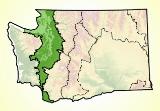 © Pete Saloutos/Panoramic Images (Washington Title Image Large)
© Pete Saloutos/Panoramic Images (Washington Title Image Large)

Puget Trough Vegetation
Historically, coniferous forest dominated the vegetation in the Puget Trough ecoregion. Many of the planet’s most impressive stands of trees grew here. Also present were a mix of riparian habitats, oak woodlands, and prairies.
The vegetation in most of the ecoregion’s landscapes has now been altered. Cities, suburbs, and industrial lands are common. Managed forests and agricultural lands changed the vegetation, and themselves face pressure from sprawling development.
The native forest here is primarily of Douglas fir, western red cedar, and western hemlock. Red alder and big leaf maple grow in riparian areas. Red alder also colonizes areas disturbed by fire or logging.
Understory plants include sword fern and shrubs such as snowberry, Oregon grape, salmonberry, and many others. In places, the forests now struggle with invasive non-native plants, such as English ivy.
Other key trees are Pacific madrone, a frequent feature on dry bluffs, and Oregon ash, common in riparian areas south toward the Columbia River.
Washington has one species of oak, the Garry oak. It is often associated with grasslands. These grasslands are one of the most threatened ecosystems in Washington. They support spectacular floral displays, including blue camas, yellow buttercup, pink seablush, and the endangered golden paintbrush.
For details of this ecoregion within Washington, click a subheading in the left column.
View the more general description of this ecoregion in North America



